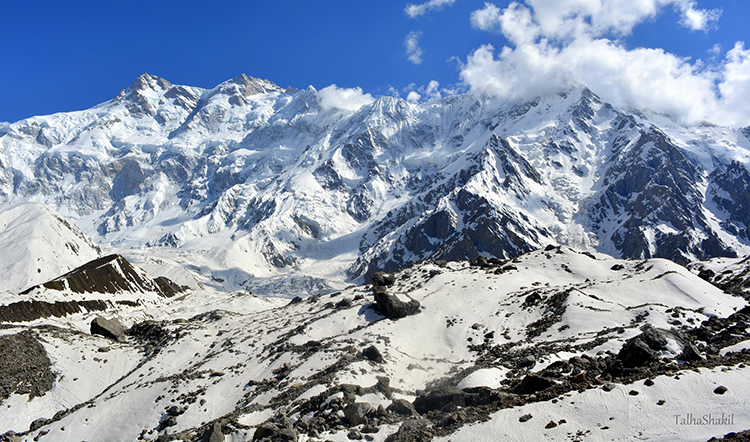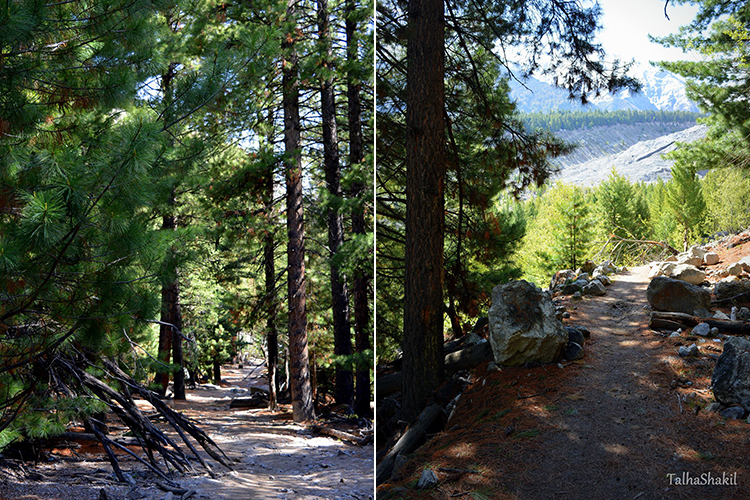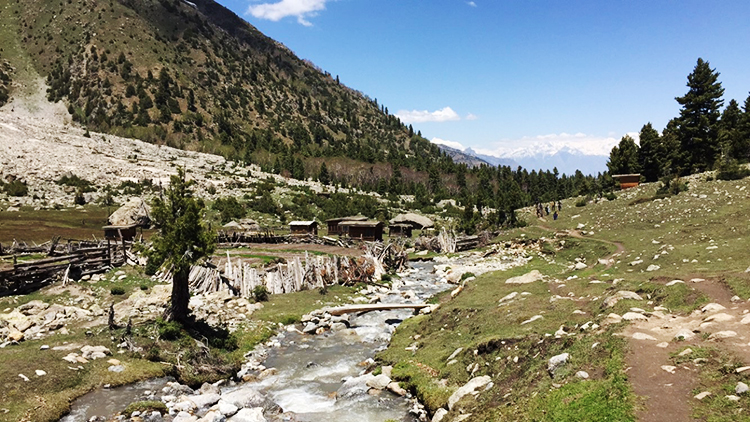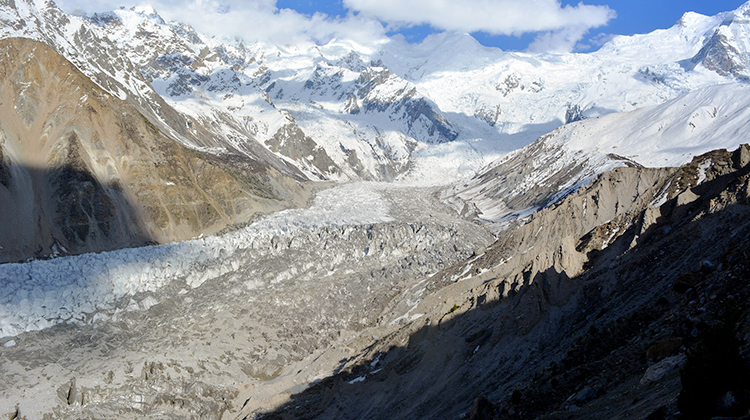Meeting the Mammoth Part II: Nanga Parbat Base Camp
Written by: Arooj Naveed Haq
Nanga Parbat (photo by Talha Shakil)
Fairy Meadows is stunning. It’s not surprising that many who set out on this journey choose to stop here, content with their effort. However, it wasn’t a lack of contentment that compelled me (and the entire group accompanying me on the trek ahead) to wake up early the day after reaching Fairy Meadows, only to set off for Nanga Parbat Base Camp.
With the promise of great sights on the way, we walked down the raised ground upon which our tents were pitched, making our way to Bayal. With a diversity of scenery to behold, this trek turned out to be so picturesque that one was hard-pressed not to stop after every fifteen minutes (or less) to pull out a camera and capture whatever one could of the stunning landscape. With thin pathways on cliffs under which lay deep valleys – occasionally a pine forest – and consistent views of sprawling snow-covered mountain-tops that seemed to be walking along with us, there was no shortage of dizzyingly beautiful topography. Almost half an hour into the trek, the narrow trail (or cliff-edge, to do it justice) opened up into a captivating choice of paths to choose from. Here, you could opt to walk under pinecone trees, or by the edge of a gushing stream. Often, you could do both.
From having to pick up logs on the way to build makeshift bridges, to hopping over small stones but inevitably getting just a little bit of water in my shoes, the walk to Bayal Camp was thrilling to say the least. The camp itself was a large open ground with little huts strewn about it. Right up ahead, you could see Nanga Parbat closer than it had been at any point thus far, standing tall. Surrounded by gushing streams of cold water on almost all sides (convenient and refreshing for the thirsty trekker), Bayal Camp was a point where the way forward and backward looked equally beautiful. Alas, we still had a long way to go.
From Bayal, it takes almost forty minutes of trekking up a steep path to reach Viewpoint One. I found this part of the journey to be quite challenging, since the path consistently got steeper and steeper – little did I know of what was to follow. Upon making it up the final slope, I collapsed on the grass and tried to steady my breath for a while.
Looking down Viewpoint One, there was a valley of glaciers. There was ice both above and below – on the right side of the trekking path to Viewpoint Two, there lay a large snow-covered mountain, of the sort we had seen looming in the distance during our trek to Bayal. Only now, it was close enough to walk on. Here, it was clear that the trek further would be significantly more challenging and time-consuming (we had to make our way back to Fairy Meadows before dark). Those leading our trek announced that it was time for us to call it a day. Naturally, the majority who had trekked this far found this declaration unacceptable, and began the trek to Viewpoint Two anyway.
This was the second most dangerous part of the trek. My decision to wear joggers (rather than trekking boots that seemed “too heavy” at the time) had its repercussions, as the path got so steep that I had to hold onto rocks and tree branches to keep from slipping down the mountain.
Perhaps a tad bit dramatic in retrospect, I wondered whether the snow-covered mountain to my right would be the last thing I ever saw (to my left was a cliff edge that gave way to a gorge filled with glaciers, clearly not the side I would want to tumble down from). At one point, hanging from a branch just before reaching Viewpoint Two, and knowing that my footing would give way any second, I remember thinking how easy it was to lose one’s life in a span of seconds. Faced with the transience of life, I thought of how inconsequential material concerns about things like academic examinations were. Thankfully, somewhere amidst these sombre musings, I had the sense to call out to others for help – and they got there just in time.
Reaching Viewpoint Two meant being on top of the snow-mountains that had formed my view during the jeep ride to Fairy Meadows and the trek to Bayal. From this point on, the trek to Nanga Parbat Base Camp involved avoiding walking over snow at all costs (there was no telling how deep one could sink in). An attempt to cross a cliffside path that was not wide enough to fit even one person’s foot at a time turned out to be futile for those who weren’t wearing the right shoes. Amidst panic, when a friend realized she was about to fall, our local guide helped us come back from the path (the edge of death might be a more suitable name for it). We then found an alternate route that required hopping over large rocks with stretches of snow between them. At one point, my friends and I rather recklessly walked through a steep stretch of snow (one foot in and then the other to check if it was steady enough).
But there it was – Nanga Parbat Base Camp – or the closest we were allowed to get to it, accounting for snow that was too deep to cross and our guides banning us from moving any farther. It wasn’t just a view of Nanga Parbat; we were now minutes away from touching the mountain. Everywhere I looked, there was blindingly white snow and ice amidst the rocky terrain.
I think of Rumi now, who writes about undergoing great turmoil to reach his Beloved, and I think of the exhaustion and fright that I had left behind me on the journey to Nanga Parbat Base Camp. When I looked all around me and beheld the most breathtaking view, all pain was forgotten. The mammoth and I had met at last.






No comments:
Post a Comment